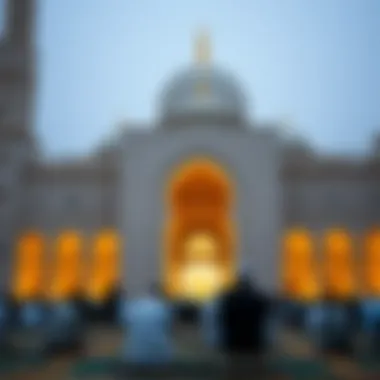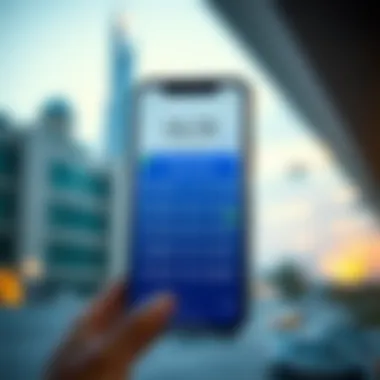Understanding Dubai's Prayer Times in 2022


Intro
Understanding prayer times in a diverse city like Dubai is essential for both locals and tourists alike. In 2022, the meticulous calculations behind these times are influenced by various factors—ranging from lunar cycles to geographical positioning. This city, which is revered for its multi-faceted culture, places substantial emphasis on the act of praying, making it a cornerstone of daily life for the Muslim community.
Having a handle on the specifics of prayer times isn't just about knowing when to pray; it reflects a deep-rooted aspect of life in Dubai. It plays a part in the rhythm of the residents' day-to-day activities, from work schedules to social gatherings. This comprehensive guide aims to unpack these timings, the methods of their calculation, variations throughout the year, and the technological solutions that support this crucial element of life.
Beyond the Basics
While many might think that prayer times are fixed and straightforward, the reality is far more intricate. Variations can occur with the seasons, particularly as different months may see shifts in daylight hours due to the Earth's rotation. Consequently, engaging with this topic involves a layered understanding of not just the times, but also their significance in the local culture and community values.
"Prayer is not a ritual; it’s a connection to the divine, intertwined with the rhythms of our lives."
In the following sections, we will delve into the key calculations behind the prayer times, highlight the technological advancements that make such data accessible, and examine cultural considerations that inform this integral aspect of life in Dubai.
Stay tuned as we explore not only the precise timings but also the rich cultural tapestry woven around these practices.
Prelims to Prayer Times
The practice of prayer, or Salah, holds a significant place in the lives of Muslims, framing their daily routines around five specified times. Understanding prayer times in Dubai is crucial not just for spiritual growth but also for fostering community connections, revealing the deep cultural fabric of this vibrant city. This article aims to navigate the intricate details of prayer times in 2022, uncovering how they are calculated and their importance in daily life for both residents and visitors.
Understanding Islamic Prayer
In Islam, prayer is not merely a ritual; it is an avenue for personal connection with God. The five obligatory prayers—Fajr, Dhuhr, Asr, Maghrib, and Isha—are spaced throughout the day, beginning with dawn and concluding at night. Each prayer has its specific time frame, guided by the position of the sun. This cycle not only structures the day for believers but also allows moments of reflection and gratitude amidst daily life.
In Dubai, where the skyline meets tradition, understanding these prayer times is essential for maintaining both personal faith and communal harmony. Many mosques broadcast the adhan, or call to prayer, signaling not just the time to pray, but creating a sense of unity among Muslims in the area.
Importance in Everyday Life
Prayer times influence various aspects of daily life in Dubai, from personal routines to business operations. For example, businesses often adjust their hours during prayer times, allowing employees a chance to fulfill their religious duties without hindrance. This respect for religious obligations fosters a sense of community and understanding that is palpable throughout the city.
Moreover, residents may plan their family gatherings or daily errands around prayer times, which emphasizes their role in social interaction. Families typically come together during the communal aspects of these prayers, most notably during Friday prayers, further strengthening social ties.
"By understanding and integrating prayer times into our lives, we not only honor our faith but contribute to the rich cultural tapestry of Dubai."
In summary, the framework of prayer times serves as a cornerstone in Islamic life, reflecting both individual spirituality and the collective identity of the community. Recognizing this significance elevates the conversation around daily life in Dubai, inviting both locals and visitors to engage more deeply with the cultural landscape.
Framework for Determining Prayer Times
Understanding how prayer times are calculated and observed is crucial for anyone engaging with the Islamic community, particularly in a culturally rich city like Dubai. These timings are not just a matter of convenience but hold profound significance in the daily rhythms of life for the residents. The framework for determining prayer times encompasses various methods that blend traditional practices with modern technology. This enhances the accuracy and accessibility of prayer timings, reflecting the community's respect for faith as well as practicality.
Calculation Methods
When we talk about calculation methods, we're diving into a world where tradition and technology meet. The way prayer times are figured out in Dubai can be influenced by several different methods—each has its own nuances. Among those, the Umm al-Qura method is the most commonly adopted one in Saudi Arabia, and it's also widely used in Dubai. This method is based on the geometric sun position, taking into account the latitude and longitude of a location to determine the precise timings of Fajr, Dhuhr, Asr, Maghrib, and Isha.
Another method worth mentioning is the Islamic Society of North America (ISNA) approach. While primarily used in North America, its underlying principles of calculating times based on the sun's angle could be applied more broadly. The angle of the sun varies notably during the year, leading to fluctuations in prayer timings, which is particularly noticeable around equinoxes.


Ultimately, many people in Dubai turn to mobile applications or websites, thanks to their accurate, real-time updates. These apps can push notifications directly to your phone, ensuring you won’t miss your prayers, especially during busy days.
Factors Affecting Timings
Several factors influence the timing of prayers in Dubai, making it essential for locals and visitors alike to stay informed. Here are key elements to consider:
- Latitude and Longitude: The geographical location impacts the angle of the sun, which directly determines when each prayer is due.
- Seasonal Changes: As the year progresses, the amount of daylight varies. This leads to significant adjustments in prayer timings, especially during the summer when days are longer.
- Local Customs: In some communities, local traditions or variations from standard practices could adjust how prayer times are observed. For instance, the community may collectively decide to start or end prayers based on cultural considerations.
- Daylight Saving Time: Though not universally applied in the UAE, any shifts or government decisions related to daylight saving could have a ripple effect on how prayer times are calculated and observed.
Understanding these nuances allows individuals to embrace their spiritual practice fully, respecting both the tradition and the modern context in which they find themselves.
By grasping how these factors interplay, one can better appreciate the richness and complexity of Islamic prayer in Dubai, turning routine observances into meaningful experiences.
Monthly Breakdown of Prayer Times in
Understanding how prayer times vary month by month is particularly vital for the Muslim community in Dubai. The significance of these patterns helps not only in managing daily activities but also enriches the spiritual experience of adherents. Different months bring their own set of influences based on how daylight changes with the seasons, thus altering the timing of the five daily prayers. This breakdown communicates the context of the communal and personal religious observance, ensuring that both residents and visitors are informed and prepared to embrace their faith smoothly, amidst the dynamic life of the emirate.
January Insights
January sets the stage for a year filled with spiritual rhythm. The prayer times during this month fluctuate subtly as daylight hours are still relatively short. For instance, Fajr, the pre-dawn prayer, starts the day around 6:00 AM, and the timing gradually shifts as the month progresses.
In Dubai, temperatures are comfortable at this time of year, making it easy for worshippers to engage in outdoor prayers or community gatherings. The integration of prayer into daily life becomes seamless, especially with festive new year's events still fresh in the minds of many.
February Summary
Moving into February, one notices a slight push in daylight hours, which influences prayer times. By mid-month, Fajr could be around 5:50 AM, while Maghrib, the evening prayer, is at approximately 6:15 PM. This gradual adjustment encourages community participation in evening prayers, particularly in local mosques where the atmosphere is warm and inviting.
February serves as a reminder for many to reflect upon their resolutions made at the beginning of the year, linking their spiritual goals with everyday practice.
Spring Months Overview
As spring rolls in, the months of March, April, and May showcase a more pronounced shift in prayer times, correlating with increasing sunlight. The days lengthen, which can create interesting dynamics in personal scheduling. Fajr creeps closer to the 5:30 AM mark by May, while Maghrib stretches out to around 6:30 PM toward the end of this period.
This time of year is not merely about logistical changes; it marks a revitalization of energy within the community. Many local organizations often plan interfaith dialogues and spiritual workshops to encourage greater understanding and cooperation among different cultural groups.
Summer Variations
June, July, and August present a unique set of challenges. Although daylight hours continue to grow, the heat can be burdensome for many worshippers. The timing for Fajr peaks around 5:00 AM, while Maghrib could be noted at about 6:30 PM. In such conditions, it's common for both residents and tourists to adapt their prayer schedules, aiming for cooler times of the day, often avoiding the searing midday sun to maintain focus and comfort.
During this period, local scholars and thought leaders remind the community of resilience and patience through spiritual messages.
Autumn Adjustments
September, October, and November showcase a transition with daylight hour reductions as temperatures begin to moderate. In September, for example, Fajr may shift back to around 5:15 AM, while Maghrib notices a gradual change toward 6:00 PM. This seasonal adjustment paves the way for communities to realign their daily activities with prayer, often igniting a renewed sense of collective spirit as festivals such as Eid Al-Adha approach.
As the autumn months unfold, the attention on prayer times becomes intertwined with plans for community and family gatherings, creating a flourishing atmosphere throughout the emirate.
Winter Reflections


Finally, December ushers in winter and the shortest days of the year. Fajr and Isha moved earlier, marking the importance of setting aside time for spiritual reflection before the year wraps up. By the end of the month, Fajr is around 6:00 AM, while Maghrib falls near 6:00 PM. Utilization of indoor spaces to reinforce community ties for prayer becomes even more emphasized, encouraging collective worship despite the cool temperatures.
This time serves as a potent reminder of gratitude and celebration of enduring faith throughout the year.
The fluctuations in prayer times are more than just schedules; they frame community life and spirituality in a constantly evolving landscape.
Understanding these monthly changes in prayer times allows individuals to better plan their personal and professional lives in sync with their spiritual obligations. With the aid of apps and online tools, tracking prayer times has never been more accessible, making the integration of faith into daily life in Dubai a seamless endeavor.
Accessing Prayer Times
In a city like Dubai, where culture and faith intricately weave a rich tapestry of life, accessing accurate prayer times is not merely a convenience, but a necessity. Understanding when to pray is essential for observant Muslims, ensuring they adhere to religious obligations while navigating the complexities of daily life. With the hustle and bustle of urban life, the challenge lies in integrating these sacred moments seamlessly into one's schedule.
Moreover, for visitors to Dubai, grasping the local prayer times can enhance their experience, offering insights into the spiritual landscape of the Emirate. Whether it’s observing the call to prayer resonate throughout the city or participating in communal prayers, being aware of these timings fosters a deeper connection to the place.
The methods of accessing prayer times have evolved significantly, providing individuals with various tools to ensure they observe prayer at the appropriate times.
Mobile Applications
Mobile applications have emerged as a cornerstone in how individuals track prayer times today. Many users appreciate the convenience of having this information at their fingertips. Applications such as Muslim Pro and IslamicFinder offer both a user-friendly interface and reliable data, catering specifically to those residing or visiting Dubai.
- User-Friendly Features: Most of these apps allow users to customize notifications, ensuring they don’t miss a prayer due to a busy schedule. Users can also adjust settings according to their local Islamic authority, helping to reflect the community's practices accurately.
- Compatibility and Accessibility: Available on both iOS and Android, these applications are accessible to many. Some even offer multilingual support, accommodating the diverse population of Dubai.
The flexibility these apps provide has contributed to a growing trend among younger Muslims and tech-savvy individuals who prefer digital solutions.
Online Resources
Beyond mobile applications, various online resources offer a wealth of information on prayer times. Websites can be a quick way for both residents and tourists to ascertain the day's prayer schedule. Notable sites like IslamicFinder and Prayer Times provide accurate timings based on geographical location and calculation method.
- Easy Updates: Many of these platforms update daily, ensuring users receive real-time information.
- Supplementary Content: Websites often include articles, guides, and community forums, offering a broad insight into Islamic practices and the cultural significance of prayer times in Dubai.
"In Dubai, embracing technology to access prayer times reflects the city's harmonization of tradition and modernization."
To summarize, accessing prayer times is not a trivial task but a significant part of daily life in Dubai. Whether through mobile apps or online resources, finding accurate timings ensures fidelity to religious practices while enriching one’s experience in this vibrant city. Keeping up with the shifting prayer schedule can provide a better understanding of local customs and assist in more mindful engagement with the community.
Cultural Context of Prayer Times in Dubai
Understanding the cultural context of prayer times in Dubai is essential for grasping the broader social fabric of this vibrant metropolis. With a population that includes a significant number of expatriates alongside native Emiratis, the rituals surrounding prayer interweave tradition with the modernity of urban life. Communication and mutual respect hinge on this understanding, offering rich insights for stakeholders in various sectors, from real estate to tourism.
In Dubai, prayer times are not just moments for spiritual connection; they serve as a framework that shapes day-to-day activities. The call to prayer, or Adhan, resonates throughout the city, creating a communal atmosphere that is palpable, whether one is in a bustling market or an upscale shopping mall. Observing these moments can foster respect among diverse communities, making it paramount for businesses and visitors alike to recognize their significance.
Integration in Daily Life
The integration of prayer times into daily life in Dubai is evident in multifaceted ways—ranging from family routines to public schedules. For many Muslims, the day revolves around these five specific times of prayer, creating a rhythm that encompasses both personal and communal dimensions. Each prayer serves as a chance to pause, reflect, and recalibrate, forming a sacred break from often fast-paced urban living.
- Daily Scheduling: Many local businesses adjust their hours around prayer times. For instance, shops may close briefly during the Dhuhr and Asr prayers, demonstrating a commitment to these practices.
- Family Traditions: Families often gather for prayers, especially during significant occasions such as Ramadan. This not only strengthens family bonds but also reinforces cultural values essential to Emirati identity. Families celebrate and share meals before and after prayers, particularly during the holy month, promoting togetherness.
- Technology Influence: Digital tools play an increasing role in helping both locals and expatriates stay attuned to prayer timings. Apps provide immediate updates and alarms that ensure no one misses these crucial moments. This adaptability illustrates how traditional practices seamlessly integrate with contemporary life.
"Prayer times are more than just rituals; they are a way of life that reflects faith and community in an ever-evolving society."


Impact on Business and Social Activities
The impact of prayer times on business and social activities in Dubai is a topic worth noting, as it affects both locals and visitors. For businesses, adhering to prayer schedules is not merely about compliance; it is about respecting a cultural cornerstone that can influence customer loyalty and engagement.
- Retail Strategies: Retailers develop strategies that accommodate prayer times. Knowing peak hours can help in scheduling employee shifts effectively, ensuring that operations run smoothly while respecting the prayer breaks.
- Dining and Socializing: Restaurants often experience a rush before or after prayer times, so aligning service with these periods is crucial. Many establishments adjust their menus to cater to customers looking for quick meals before they head off to pray.
- Event Planning: For event managers, aligning the timing of functions with prayer schedules is essential. This consideration demonstrates cultural mindfulness and can significantly enhance attendance and enjoyment for participants.
Overall, the cultural context of prayer times in Dubai serves not only as a guide for religious observance but also acts as a thoughtful framework that influences various aspects of local life. Recognizing and adapting to these cultural nuances can benefit stakeholders eager to engage with the community more meaningfully.
Challenges Faced by Locals and Visitors
Navigating prayer times in Dubai is a multifaceted challenge, especially for newcomers and visitors. This section sheds light on specific hurdles that local residents and tourists might encounter, aiming to provide a clearer understanding of these intricacies.
Adjusting to New Time Zones
Adjusting to time zones can be a tricky business for anyone, but it hits a little differently for those visiting a region with a commitment to religious observances. Dubai operates under Gulf Standard Time, which is UTC+4. This timing is crucial since it governs all daily activities, including the five daily prayers.
For visitors arriving from far-off places like North America or Europe, the shift can be jarring. One moment you're basking in daylight, the next, you're fumbling to recall when you need to pause for prayer. The Fajr prayer, often held before dawn, might require an extra cup of coffee just to ensure you’re awake on time.
Here are a few things to consider when adjusting:
- Sleep Patterns: Your body's internal clock, known as circadian rhythm, can take a while to adapt. It’s best to slowly acclimate by adjusting your schedule gradually in the days leading to your travel.
- Mobile Notifications: Using apps that track prayer times not only helps keep you in the loop but can alleviate some of the stress caused by time lag.
- Public Spaces: Many locations, including shopping malls and parks, are designed with prayer facilities. Being aware of those locations can help you plan your day.
"Finding a place to pray is often just a few steps away in Dubai, but timing it right is key!"
Understanding Local Customs
Understanding the local customs surrounding prayer times goes beyond merely knowing the hours. It’s woven into the very fabric of everyday life in Dubai. For newcomers, or even seasoned travelers, failing to grasp these cultural nuances could result in feelings of awkwardness or even social faux pas.
Consider the following aspects:
- Respectful Timing: During prayer times, businesses might close their doors briefly. As a visitor, it’s important to recognize this and adapt your schedule accordingly. Remaining patient during this pause can deepen your appreciation for the traditions of the local populace.
- Social Interactions: Engaging with locals during these times requires an awareness that prayer might take precedence over social activities. Planning lunches or meetings around these schedules can lead to smoother interactions.
- Dress Code and Behavior: While Dubai is relatively liberal, modesty goes a long way, particularly during prayer times. Visitors should make an effort to dress appropriately, especially near mosques or while participating in communal prayers.
Adhering to these cultural sensitivities demonstrates a respect for the rich traditions of the Emirati culture and fosters a deeper connection. It’s about being both aware and respectful, as this willingness to adapt often leads to enriched experiences in this vibrant city.
The End and Future Considerations
As we reflect on the importance of prayer times in Dubai, it is evident that these timings are not just a schedule but a fundamental aspect of the lives of many individuals. Understanding the dynamics surrounding these times can facilitate a deeper appreciation for the spiritual practices and cultural nuances prevalent in the region. For both local residents and expatriates, prayer provides a rhythm to daily life, fostering community and personal reflection.
Reflections on Spiritual Practices
In a society that thrives on diversity, the spiritual practices associated with prayer times serve as a unifying thread in the fabric of Dubai. Observing these times helps individuals pause and reflect, regardless of personal beliefs. There's a unique harmony found in the moments when the call to prayer resonates through the air, encouraging people to connect with their inner selves. It's not merely about fulfilling a religious obligation; it's an opportunity to step away from the hustle and bustle, realigning one's thoughts and intentions.
Moreover, prayer times can influence various aspects of life, from work schedules to social gatherings. For instance, many businesses in Dubai accommodate prayer times, exemplifying respect for the practice and providing space for employees to engage spiritually.
Anticipating Changes in Timings
Looking ahead, it's crucial to consider how prayer timings may evolve with the changing demographics and technologies. For example, the integration of mobile applications such as Muslim Pro or websites offering real-time updates on prayer times illustrates how the traditional practices are adapting to modern needs. As urban landscapes expand and develop, the calculation of prayer times could become more nuanced due to shifts in geographical observations such as latitude or building heights.
Key considerations for the future include:
- New technologies that might affect real-time calculations of prayer times.
- Adjustments during fasting months like Ramadan, when timings shift.
- Cultural integration as more communities blend in this vibrant city, influencing collective practices.
The understanding and consideration of these changes can lead to a richer and more inclusive environment for spiritual practices in Dubai.



